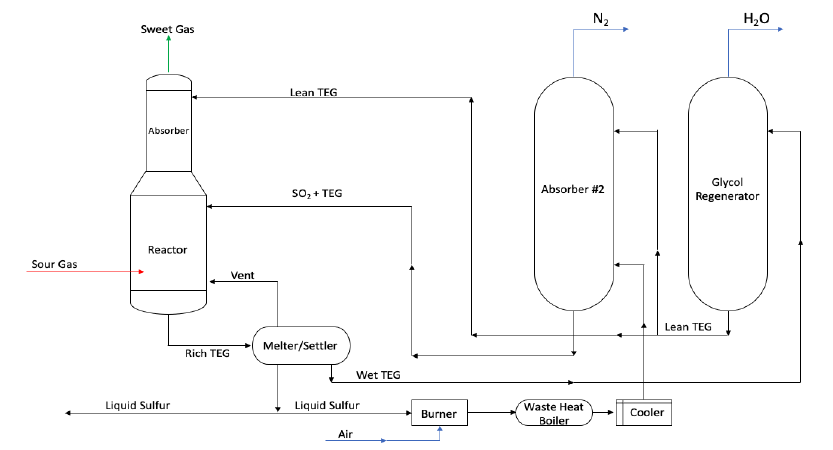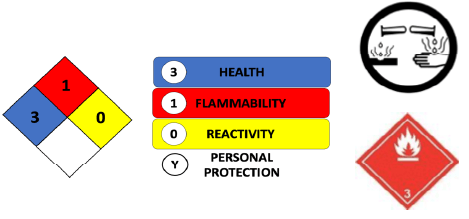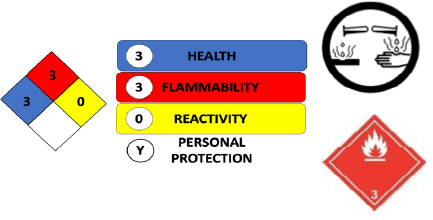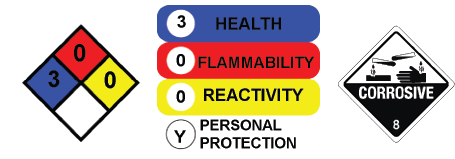Apollo's Vap-X Gas Blend Working to Mitigate H2S and CO2, Greatly Reducing Nitrogen
Challenge
Find a solution to mitigate hydrogen sulfide (H2S), carbon dioxide (CO2), and Nitrogen (N) in gas phase. Help replace an Amine plant.
Solution
Apply Apollo's Vap-XTM suite of chemistries to improve, manage, and mitigate H2S, CO2, and N in gas phase. It will allow producer to manage gas in the midstream sales line.
Results
- Reduce H2S and CO2 levels to allow for gas sales.
- Improve overall safety and integrity of company assets.
- Demonstrated the effectiveness of Apollo's Vap-XTM suite of chemistry at mitigating H2S and CO2 with possibility of taking Amine plant offline.
Apollo's Vap-XTM gas blend working to mitigate H2S and CO2 and greatly reducing Nitrogen
Cleaning the Gas to Bypass Midstream
Reduce Hydrogen Sulfide in sour crude oil and gas.
Hydrogen Sulfide is naturally produced in oil formations. The levels can range from a few ppm up to 250,000 ppm hydrogen sulfide and must be reduced to below pipeline specifications, which are typically less than 10 ppm. In addition to reducing product value, hydrogen sulfide exposes producers to environmental and safety risk. It also can increase the chance of corrosion.
Producer in Arkansas currently deals with moderate levels of H2S. Apollo suggested treating the Hydrogen Sulfide using their Vap-X Gas Phase product which will reduce the H2S in gas phase thus allowing for a lower gas spec. Apollo also was made aware that the stream was 1800 ppm of H2S, 66,000 ppm of CO2, as well as over 160k ppm of Nitrogen. Apollo's goal is to reduce the levels so then the gas to be sold to midstream for gas processing.
The pilot testing began on March 8, 2022 at approximately 9:30 CST. For the inItial testing we loaded 330 gallons of the Vap-X Gas Phase chemistry into the vessel picture below. Apollo also will run for a very brief period an inlet injection before the gas enters the piping loop to help lower the contaminants before the gas is introduced into the bottom of the vessel. Since no water wash was able to be utilized Apollo felt a short run would be beneficial to establish some data. As the well came online and started to flow it was assumed that the vessel was treating rougly 280 mcf. The pressure was between 25-30 psi so low pressure. The initial raw data that was pulled was 1400 ppm of H2S, 60,000 ppm of CO2, and Apollo also monitored water vapor. In this stream the raw data for water vapor was 3mg/L. Apollo monitors the water vapor because the chemistry will dry the gas, which will in turn play a role in diluting out the chemistry.
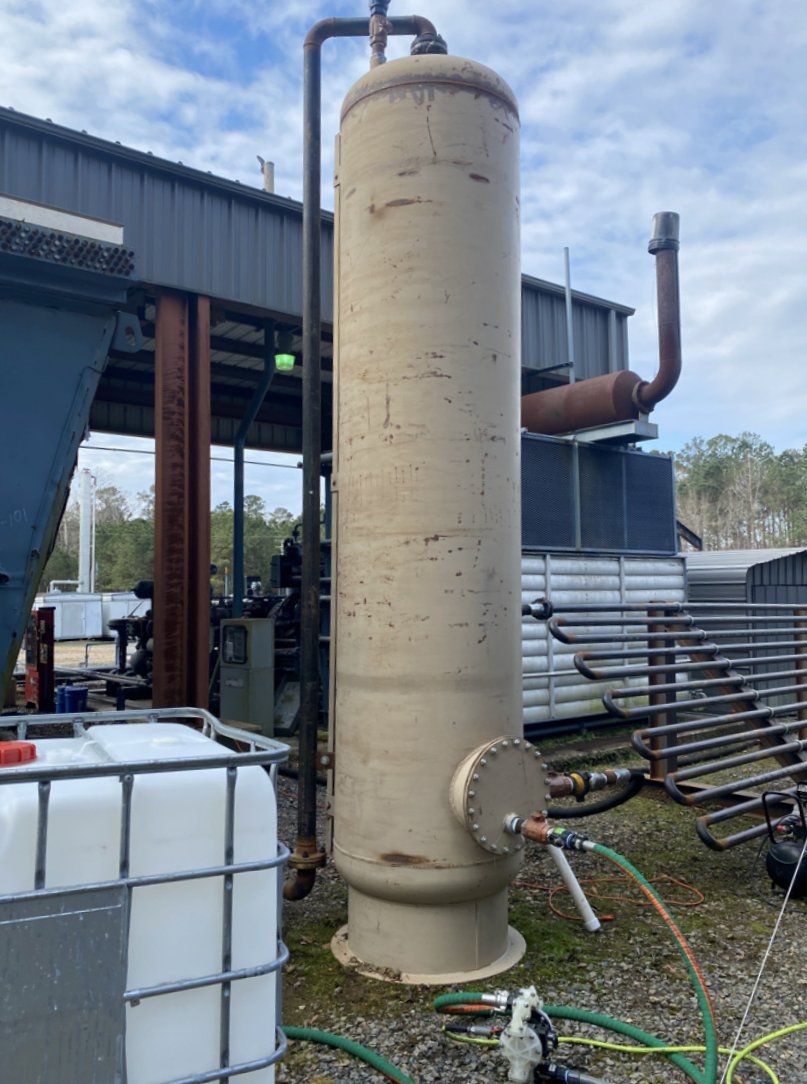
330 Gallons of Vap-X™ Gas Phase Added in Vessel Above
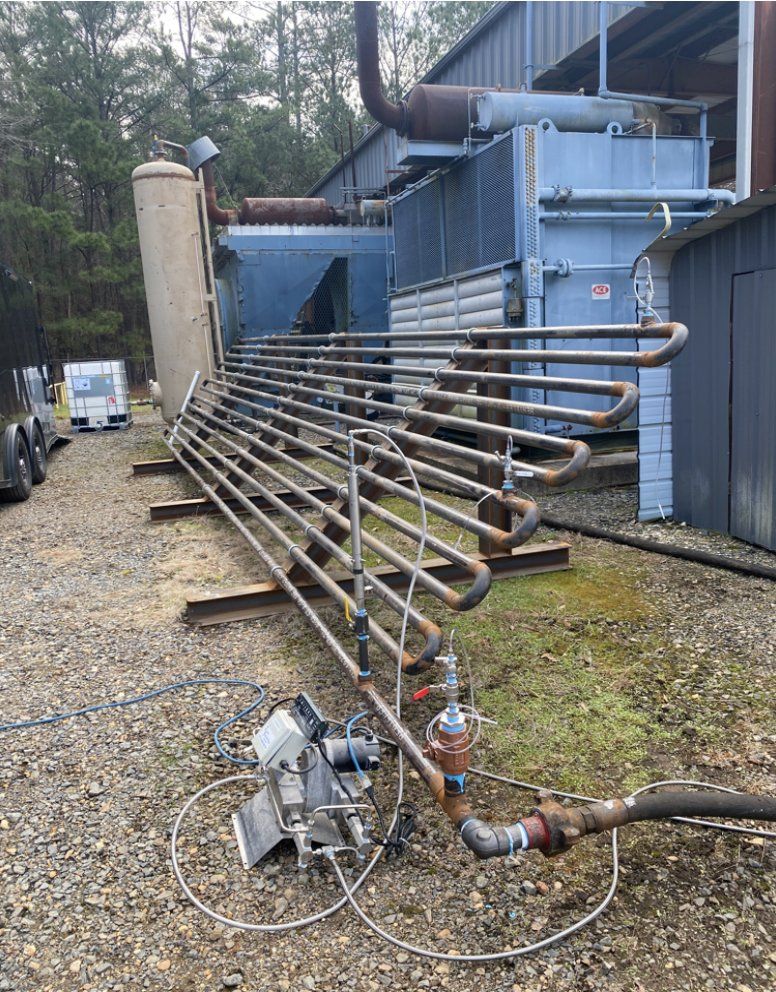
Initial Injection Point as well as Testing Points
As treatment started the initial numbers came in very well. Apollo had some concern due to not having a water wash that the initial
injection would be beneficial. In most applications with treating in pipe gas only, Apollo has seen great results by allowing water to be
introduced which also give a fluid for the treated contaminants to go into. Apollo also will be monitoring the treated data from the initial
injection alone (this data will be delivered with an asterisk * next to the info). Throughout this test it was noted that the initial injection point did not have near the expected results than having a water wash would have been able to produce.
| Date | Time | Treated H2S (PPM) | Treated CO2 (PPM) | Water Vapor (mg/L) | Inlet Injection (gallons/hr) |
|---|---|---|---|---|---|
| 03/08/22 | 10:00 AM | 0 | 0 | 2 | 5 |
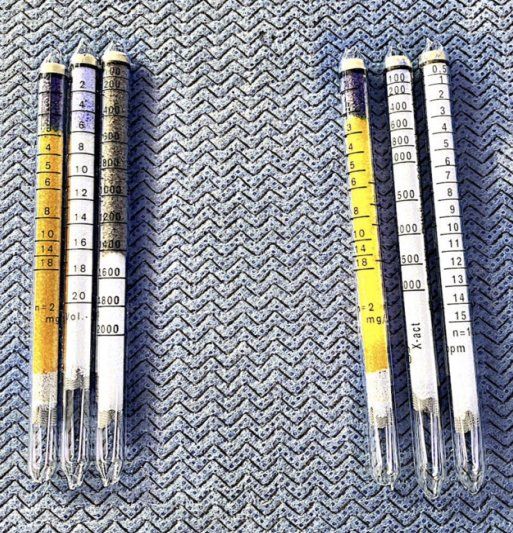
Drager tubes Showing Raw Data on Left and treated Data on Right.
First Tube in Each Section is Water Vaport, Second Tube is CO2, and Third Tube is H2S.
| Date | Time | Treated H2S (PPM) | Treated CO2 (PPM) | Water Vapor (mg/L) | Inlet Injection (gallons/hr) |
|---|---|---|---|---|---|
| 03/08/22* | 11:00 AM* | 750* | 55,000* | - | 5* |
| 03/08/22 | 11:00 AM | 0 | 150 | 2 | 5 |
| 03/08/22 | 12:00 PM | 400* | 55,000* | - | 10* |
| 03/08/22 | 12:00 PM | 0 | 150 | 2 | 10 |
| 03/08/22 | 1:00 PM | 0 | 150 | - | 0 |
| 03/08/22 | 3:00 PM | 0 | 0 | - | 0 |
| 03/08/22 | 4:00 PM | 0 | 0 | - | 0 |
| 03/08/22 | 5:00 PM | 0 | 0 | - | 0 |
| 03/08/22 | 6:00 PM | 0 | 0 | - | 0 |
| 03/08/22 | 7:00 PM | 0 | 0 | - | 0 |
| 03/08/22 | 8:00 PM | 0 | 0 | - | 0 |
| 03/08/22 | 9:00 PM | 0 | 0 | - | 0 |
| 03/08/22 | 10:00 PM | 0 | 0 | - | 0 |
| 03/08/22 | 11:00 PM | 0 | 0 | - | 0 |
| 03/09/22 | 12:00 AM | 0 | 0 | - | 0 |
| 03/09/22 | 1:00 AM | 0 | 0 | - | 0 |
| 03/09/22 | 2:00 AM | 0 | 0 | - | 0 |
At 2:00 AM on 3/9/22 the test was called off due to running out of drager tubes for the testing of the gas. Colby did note that the vessel felt warmed when he arrived back on location at 7:00 AM. Apollo made it known that if the chemical is stagnant without gas running through it reactions would continue. Due to this the chemical will spend even if gas is not being flowed thru the vessel. When a sample of the chemistry was pulled before startup the pH of the chemistry was 10 pH. In the morning of 3/9/22 Apollo along with Colby decided to turn the gas and the vessel back on.
| Date | Time | Treated H2S (PPM) | Treated CO2 (PPM) | Water Vapor (mg/L) | Inlet Injection (gallons/hr) |
|---|---|---|---|---|---|
| 03/09/22 | 8:30 AM | 0 | 0 | - | 0 |
| 03/09/22 | 9:00 AM | 0 | 0 | - | 0 |
| 03/09/22 | 10:00 AM | 0 | 0 | - | 0 |
The testing went very well. Results were very good considering the contaminants that were in the gas. Apollo would like to continue testing further. Apollo after talking with Colby would be able to introduce a water wash in the pipes along with adding a coalescer to take out the fluid. This will be very beneficial in allowing a larger reduction with the initial injection and it will also lower the water vapor in the gas stream. Apollo would also test a new chemistry in the vessel that it is calling Vap-X™ Gas Phase 2.0. Please see the information below from the three different samples that were pulled during testing and the results when viewing them thru a GC (gas chromatography).
Samples Provided: three 5 liter samples were obtained. Raw, Treated at 10 AM, Treated at 1 PM GCMS
Raw Sample: shows high compositions of Nitrogen, Carbon Dioxide, Hydrogen Sulfide and aprox 40% by volume methane, also consistent pentane, butane, propane, and other contaminate compounds.
Treated Sample at 10 AM: shows the gas is fairly clean with the H2S, CO2, and some of the other contaminates are mitigated to trace elements. The treated methane gas volume increased to approximately greater than 90% by volume, much cleaner with no loss of the integrity of the natural gas (methane) and other elements as pentane, propane, butane. components wanted in the natural gas having BTU value.
Treated Sample at 1 PM: shows the gas is greatly cleaned up with the H2S, CO2, and some of the other contaminates are mitigated to trace elements. The treated methane gas volume increased to approximately greater than 95% by volume, much cleaner with no loss of the integrity of the natural gas methane and other elements as pentane, propane, butane. components wanted in the natural gas having BTU value. Cliff Roe (Apollo Chief Scientist) believes this gas is clean enough to make LNG at the well head. The water vapor has diminished substantially equaling equilibrium. The quality and integrity of the gas is extremely clean with very low trace contaminates (meaning parts per billion or trillion contaminate counts).
